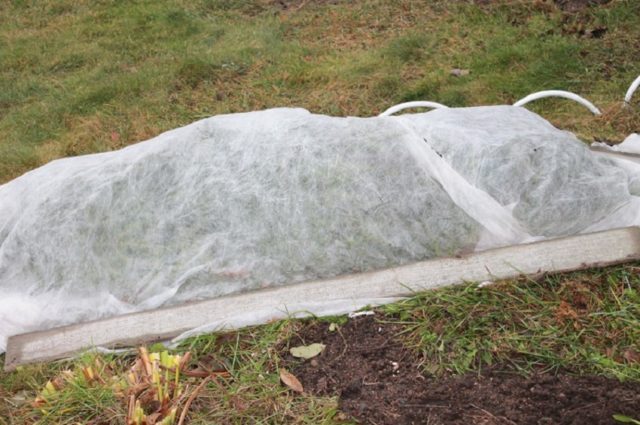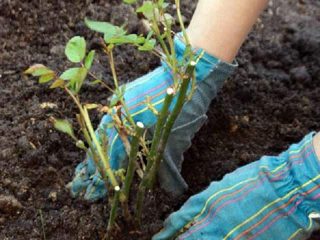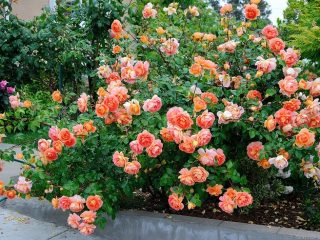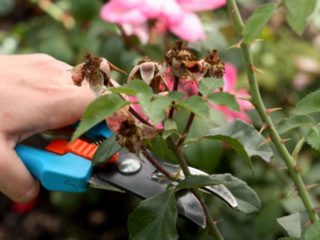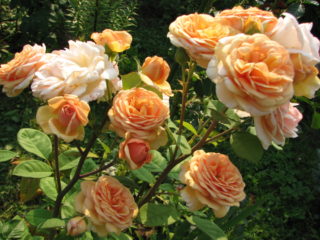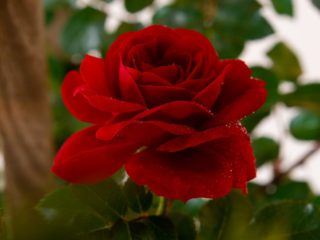Content
The climbing rose Lavinia belongs to the Climber species. These varieties are very popular among gardeners. The reason is the ability to grow Lavinia not only to decorate the garden, but also as a cut plant. In addition, Tantau selection roses have good immunity, winter hardiness, high decorative value, and resistance to rain.

Lavinia from the Tantau line belongs to the elite species
History of selection
The climbing variety Lavinia was obtained by a breeder from the German company Tantau Rosen, which breeds luxury roses. His name is Mathias Tantau Jr. Hybrid varieties were taken for crossing. However, the exact name of the parental forms of the rose is not known with certainty. Lavinia appeared in the early 90s of the last century, and by the beginning of the new century the variety had become known far beyond the borders of the country.
Awards
Among the awards of the climbing beauty Lavinia, the most significant ones should be noted:
- Honorary award in the USA for participation in the thematic flower exhibition Syracuse Rose Society Show - 1999.
- Title "Best Climbing Rose" from the American Rose Society AARS - 1999.
- Royal Horticultural Society (RHS) Award - 2000.
In addition to the awards listed, the climbing rose Lavinia has a huge number of enthusiastic reviews from amateur gardeners.
Description and characteristics of climbing rose Lavinia
The variety has typical climber characteristics. External parameters of the plant:
- The bush is about 3 m high. The crown width is from 1.5 m to 2 m.
- The root system of an adult Lavinia rose is highly developed, going 2 m deep.
- The branches are long, strongly branched. Very durable and flexible. It is difficult to break them, but it is easy to create curved compositions. The spikes are large. The Lavinia variety does not require the installation of supports.
- Leaves. Regular, dark green, large, very dense. The surface is glossy. On one petiole there are 4 leaves arranged in pairs and 1 leaf as the apex. The edges of the plates are serrated.
- Inflorescences. Drooping, formed at the ends of the shoots. They consist of 2-3 flowers (usually); Lavinia rose inflorescences also often have 7 buds.
- Medium sized buds, very elegant. The shape resembles a bowl. The flowers are large, double, the size of one is about 9 cm, and consist of 25-30 petals. The color is pink. At the base of the flower the shade is more saturated, near the top it is much lighter. At the moment of dissolution, the petals bend back, making the darker center visible. The aroma of Lavinia rose is pleasant, with fruity notes, rich.
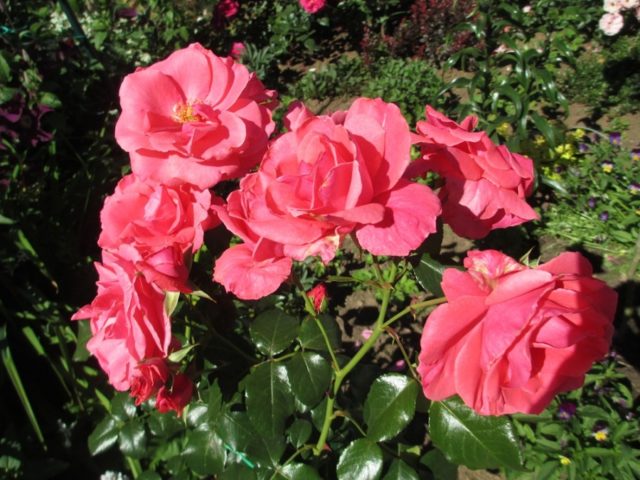
Flowers are the main asset of a climbing rose
The bottom of the Lavinia rose bush is often exposed due to the location of the inflorescences at the top of the shoot. To avoid this, it is recommended to do cascade pruning of the perennial. The second option is to try to tilt the branches closer to the ground. Then the variety forms buds along the entire length of the shoot.
Tender Lavinia blooms in 2 or 3 waves per season.The variety is re-flowering.
If the rose is provided with high-quality care, then it forms the first buds in June, and finishes flowering in late autumn. Lavinia's flower does not stay on the bush for too long. But the number of brushes combined with the buds ready to bloom provides the rose with a decorative effect for a long time.
The color of the petals of the variety is resistant to sunlight. In active sun, only the tips of the petals become a little paler, and the entire bud remains deep pink.
In addition to the listed parameters, the climbing rose Lavinia has a lot of excellent characteristics. Among them is good frost resistance, corresponding to USDA zone 5. An adult Lavinia bush overwinters at -29°C without significant damage. However, leaving the rose in cool regions without shelter is not recommended.
Advantages and disadvantages of the variety
Lavinia is a very beautiful climbing rose. It is present in areas of regions with any climatic characteristics.
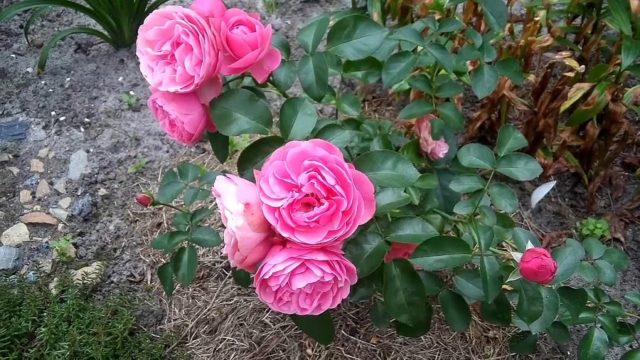
Knowing the pros and cons of a variety will allow you to calculate the gardener’s workload
According to gardeners, the positive qualities of the Lavinia variety are:
- abundant long-term rose bloom;
- large-flowered;
- high winter hardiness and heat resistance;
- excellent immunity when following agricultural cultivation techniques;
- lasts a long time in a vase after cutting;
- possibility of breeding the variety from seeds.
The Lavinia variety also has disadvantages:
- dimensions of an adult bush;
- poor resistance of buds to rain.
Despite some disadvantages, climbing rose Lavinia is a favorite variety of many gardeners.
Reproduction methods
You can obtain young perennial seedlings in different ways. In spring, it is recommended to take cuttings from a climbing variety. Planting material should be cut from healthy, powerful rose shoots. Lavinia cuttings should be at least 0.5-0.7 cm thick and about 16-20 cm long. Make the upper cut straight, the lower one at an angle of 45 °. The number of buds ready for growth is at least 3 pieces. Place the cuttings in Heteroauxin or Kornevin solution for 12 hours, then plant. Prepare the soil from a mixture of sand and earth (1:1). If you decide to cut the variety in the fall, the process will be a little simpler. Place a drainage layer on the bottom of the container, then soil with sand and peat. Pour water and place the cutting. Make several holes in a plastic bottle and cover the cutting. The climbing rose seedling will be ready for planting next spring.
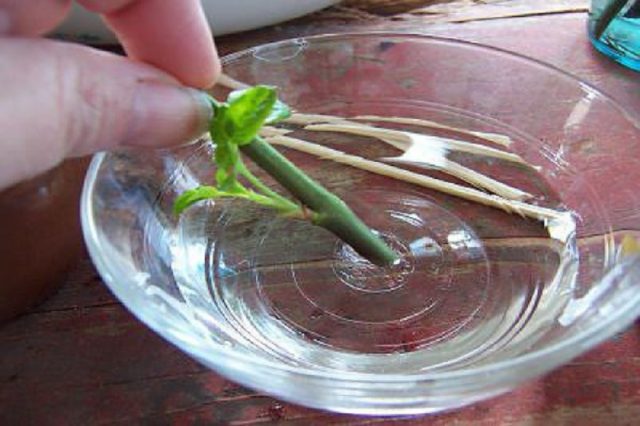
Cuttings will preserve varietal characteristics
To propagate Lavinia by layering, shoots growing at the root collar are used. In early spring (early March), you need to bend them to the ground, place them in small grooves, and sprinkle them with soil. Provide the future rose with regular watering.
The seed method is only suitable for seeds purchased in a store. The timing of sowing and technology for growing seedlings are traditional for climbing roses.
Growing and care
Even a novice gardener can grow the Lavinia variety. The main thing is to perform the necessary actions in a certain order:
- meet deadlines;
- choose planting material;
- prepare the place and soil;
- plant a climbing rose;
- provide competent care.
Each stage has nuances:
- Planting dates for the Lavini varietyI. In spring, it is recommended to plant seedlings from the end of April to May 10. This is the best period for warm regions.In the middle zone, the dates shift by almost a month - the end of May or the beginning of June. Autumn planting of the climbing rose variety should be carried out from October 1 to October 15. Seedlings with a closed root system can be planted during the season.
- Selection of planting materialA. It is necessary to pay attention to several points. A high-quality Lavinia rose seedling should have 2-4 semi-lignified shoots directed in different directions. The condition of the bark is without wrinkled areas or spots. There should be no peeling of the bark at the site of grafting of the variety. The buds are in the swelling stage, the roots are dark brown, elastic. Before planting, cut the roots of the variety to 30 cm and the shoots to 20 cm in length.
- Preparing the site. It is necessary to take into account the size of the bush and its life expectancy. For a climbing variety, you should choose a lighted area with fertile, loose soil. It is best if it is loam with neutral acidity. Groundwater on the site should lie at a depth of no higher than 2 m from the surface. It is necessary to monitor the location of neighboring plants. Lavinia does not tolerate acidic soil. Therefore, there should be no crops nearby that require acidification, such as hydrangeas.
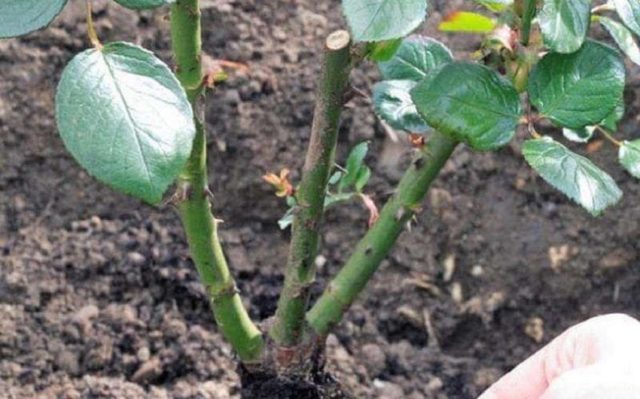
Only healthy, strong seedlings are suitable for planting
The process of planting the Lavinia variety:
- prepare a planting hole in the form of a cube with sides 50 cm;
- lay a layer of drainage, then soil for roses;
- add 40 g of superphosphate and 20 g of potassium salt;
- mix the soil with fertilizers, add more soil on top;
- place the seedling in the hole, smooth out the roots;
- sprinkle with soil, compact slightly;
- water with settled water;
- mulch the planting area.
After proper planting, the seedlings of the variety take root well.The Lawinia rose cannot be called completely unpretentious. Therefore, without proper care, she will not show her best qualities. The plant needs:
- Proper watering. It is recommended to water the variety once a week; each Lavinia bush requires 10 liters of water. At elevated air temperatures (more than 25 °C), the frequency of watering is increased to 1 time every 5 days. The main requirement is to prevent stagnation of moisture, so as not to provoke rotting of the roots.
- Dosed fertilizers. When young leaves appear and before buds begin to form, nitrogen fertilizers must be applied. When a rose enters its flowering period, it requires phosphorus and potassium. It is best to use mineral complexes to nourish roses.Important! The plant should not be fed for the first year after planting.
- Preventative treatments. In spring, spray the bush with a solution of iron sulfate (3%). Regular weeding and mulching of the near-trunk zone of the variety is considered a good way to prevent the appearance of pests and diseases.
- Regular pruning. This is a must when caring for climbing varieties of roses. The main time for climbers is spring. Pruning allows you to remove old, diseased and damaged shoots, as well as form a crown. It is important to remember that flowers are formed on branches of the 2nd year. You should also regularly remove shoots growing below the grafting point. In summer, many gardeners advise shortening shoots by 1/3 of their length after flowering. It is necessary to remove all rose branches older than 3 years.
- Preparing for winter. Untie the branches from the supports, bend them to the ground, and press them with spears. Cover the top with spruce branches or appropriate covering material. In the spring, remove everything.
In cool areas, the climbing variety requires shelter for the winter.
If you decide to transplant a Lavinia rose, this should be done in the fall.Be sure to save the earthen ball so that the plant takes root well.
Pests and diseases
When following the rules of agricultural technology, gardeners do not complain about the health of the rose bush. But the plant can be visited by pests that are on neighboring crops. For example, aphids, spider mites, thrips, bronzes. You have to fight them with folk remedies (soap solution) or use insecticides (in case of large accumulations).
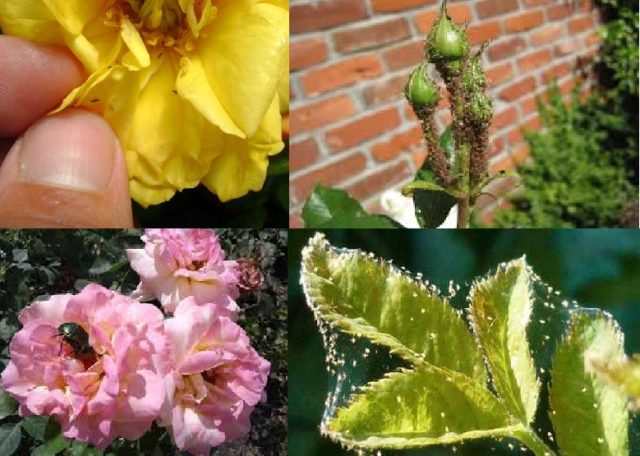
If any pest is detected, measures should be taken immediately to save the climbing rose.
When there is a violation of the watering schedule, the Lavinia variety may get sick. The main problems are gray rot and powdery mildew. The affected areas must be removed and the rose treated with fungicides.
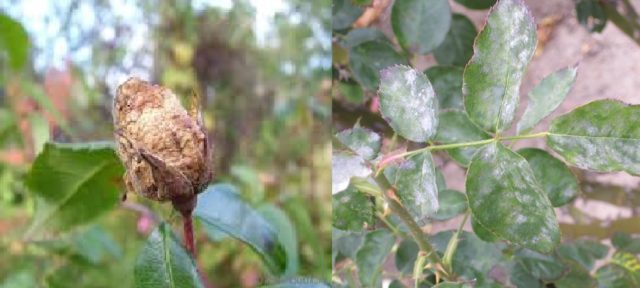
Fungal diseases require immediate treatment, otherwise the crop may die
Application in landscape design
There are several recommendations from experienced designers for using the climbing rose Lavinia in garden compositions. It goes best with conifers, for example, thuja. By combining these two plants, you can get an original hedge. The main thing is to maintain a distance of 1-1.5 m between them. Bells, sage, cereals, and lavender are considered excellent neighbors for climbing roses. Clematis can be replanted when the bush reaches the age of 2-3 years.
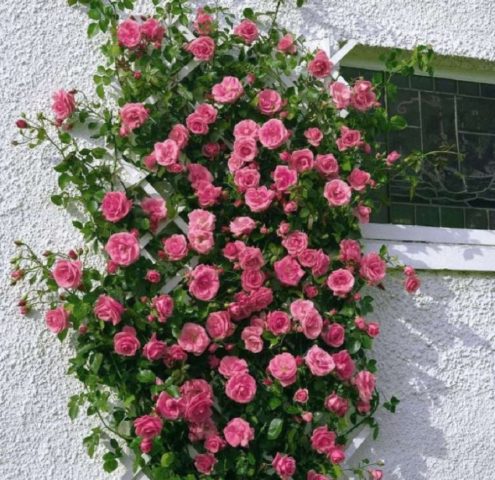
Even without neighbors, the decorative quality of a climbing rose remains at its best
It is not recommended to plant Lavinia next to plants that quickly grow in width and fill a large space. Rose loses her attractiveness. Mixed flower arrangements, which make caring for the bush difficult, are also not suitable. The variety does not develop well next to large plants. Tall birch, spruce or pine will make it difficult for it to absorb moisture and nutrients in the right quantities.
Conclusion
The climbing rose Lavinia can decorate an area of any style and size. To do this, it is necessary to fulfill all the requirements of the bush’s agricultural technology. Planting and post-planting care are especially important. Compliance with the recommendations is the key to long and abundant flowering of climbing roses.
